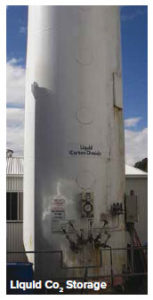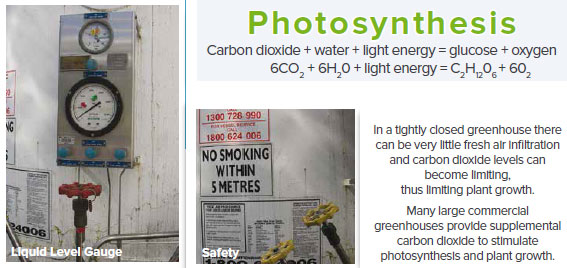By IAN GESCH University of Queensland

CO2 greenhouse capture technology ahead;
Greater availability, reduced costs and better environmental outcomes
CO2 StorageCarbon dioxide (CO2) enrichment in greenhouses is essential to reverse depletion.
Increasing CO2 concentrations above ambient levels has obvious and proven benefits for yield, but what is the true cost of this practice?
Producing CO2 from the combustion of natural gas and LPG is common in commercial greenhouses.
Also common is the monitoring of CO2 levels in the growing environment.
However, measuring the actual amounts of CO2 released into the growing environment is rarely measured or monitored.
Converting from litres of gas to kilograms of CO2 means that LPG at 60 cents per litre translates to a cost of $390 per tonne of CO2.
Similarly, natural gas at $13 per gigajoule translates to a cost of $250 per tonne
of CO2.
A 10 hectare greenhouse will consume over 3,000 tonnes of CO2 per annum and still not reach ideal enrichment levels.
While CO2 is a valuable commodity for commercial greenhouses, it is a waste product for other industries.
The Australian government priced CO2 at less than $25 per tonne when the carbon tax was in place.
The last reverse auction conducted under the current government’s direct action policy priced CO2 at less than $14 per tonne.
The cost of CO2 on the Californian cap-and-trade system is about $15 and less than $5 per tonne on the European Union carbon market.
Companies in the USA use an internal carbon price of $30 to $60 per tonne for strategic planning.
While these figures do not reflect the price of CO2 as a commodity, they do reflect a common and influential view of the value of CO2.
Industries such as brewing, natural gas production and fertiliser manufacture produce large quantities of relatively pure CO2 and just vent it to atmosphere.
Large emitters such as coal fired power stations are expecting changes to legislation that will make the continued emission of CO2 an expensive practice.
They are investing significant R&D funding into CO2 capture as a result.
There is even R&D into capturing CO2 off small coal and biomass boilers, although this process does consume a significant amount of energy.
CO2 Enrichment

Another source of CO2 is the combustion of methane released from waste water such as sewerage treatment plants and piggery effluent ponds.
While this CO2 stream is quite dilute, a typical effluent pond will provide enough CO2 to satisfy or exceed the demands of most commercial greenhouses with little or no scrubbing or cleaning required.
Owners and operators of commercial greenhouses can benefit from a changing policy landscape.
CO2 capture is getting cheaper and emitters of CO2 are becoming more aware of the need to act.
This should translate into increasing supply and decreasing cost of “waste” CO2.
The True Cost of CO2
Ian Gesch – ian.gesch@uq.net.au
UQ Research Project Leader aiming to identify sustainable alternatives to LPG for commercial greenhouse heating.
